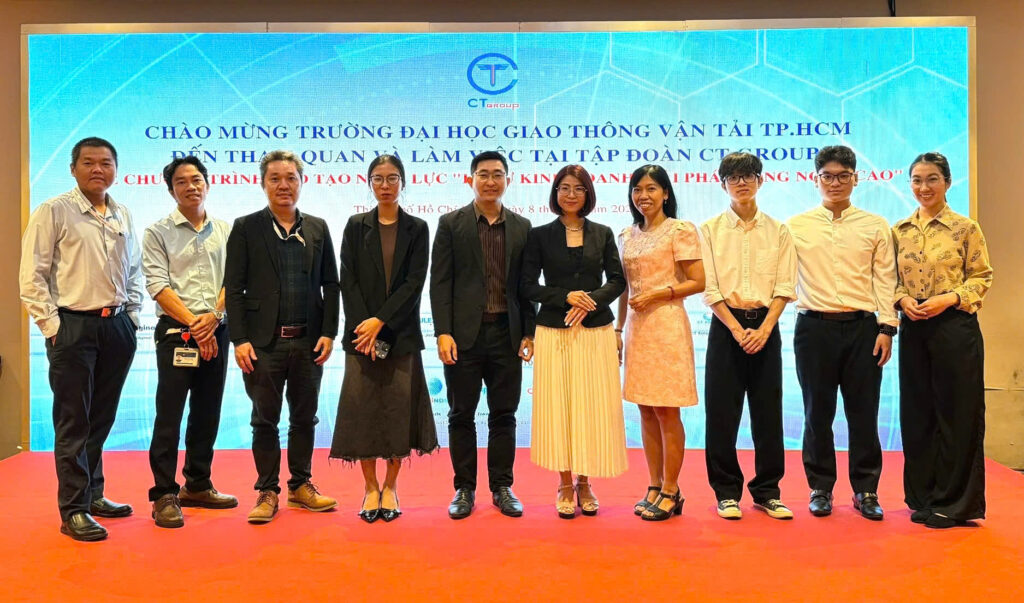Metro Star, a real estate project by CT Group, is among the first in Vietnam to tap the transit-oriented development (TOD) model now considered key to developing compact urban areas.
Japan, South Korea, China, Singapore and other trendsetters have implemented the TOD model for many years, reaping transportation, urban growth and other socio-economic gains.
Viable development model
In recent years, there has been increasing recognition in Vietnam that with current and upcoming metro systems, the TOD model offers a viable solution for overpopulated cities like Ho Chi Minh City.
At the moment, Metro Line No. 1 in Ho Chi Minh City (Ben Thanh-Suoi Tien) is 98% complete and set to begin commercial operations in November 2024.
The first urban railway project in the southern metropolis, 20 kilometers long, has a total investment of more than VND43,700 billion ($1.73 billion).

An under-construction pedestrian overpass connecting with a Metro line No.1 station in HCMC. Photo courtesy of CT Group.
Once operational, the metro line is expected to become a driving force for the city’s development, especially in renovating its eastern part. Besides, construction of the 11-kilometer Metro Line No. 2 (Ben Thanh-Tham Luong) will facilitate underground developments in a city where overland resources are becoming scarce with every passing day.
The city is also planning a 220-kilometer urban railway network that will boost regional connectivity.
Pedestrian bridges connecting Metro Line No.1 stations with sections of Vo Nguyen Giap Avenue are being completed one after another. These bridges will become the main gateway for residents on the eastern side of the Metro Line to use its stations and access the city’s downtown area.
Therefore, real estate projects next to metro stations will be the first to benefit handsomely from their prime locations. With the metro line as their core, urban spaces surrounding the public transport system will become top real estate products with great added value aspects.
Under the TOD model, residents of such spaces will have convenient and safe access to modern urban transport systems, including the metro lines. The confluence of the model with modern public transport systems will turn the areas near the stations into attractive zones populated with multiple-purpose areas including houses, commercial centers, recreational areas, restaurants and offices.
It’s worth noting that the TOD model helps optimize land use, reduce traffic jams and emissions, reduce travel time, improve residents’ health and quality of life, and increase real estate values.
Model growth
A leading light among real estate projects tapping the TOD trend is the Metro Star complex developed by the eponymous company, a member of CT Group.
It is a rare project with a pedestrian overpass from from the second floor to the commercial center across Vo Nguyen Giap Avenue to Binh Thai Station on Metro Line No. 1.
This area will be the center of attention when the metro line becomes operational at the end of this year. It will become the green TOD traffic gateway for the entire populated area to the east of HCMC, from Cat Lai Bridge to Ring Road 2 and Vo Nguyen Giap Avenue, as also a link between Ring Road 2 via Pham Van Dong and Mai Chi Tho roads.
Notably, Metro Star plans to develop a chain of more than 50 green TOD projects along eight metro lines in HCMC.

An illustration of the Metro Star project in HCMC. Photo courtesy of CT Group.
As a multi-sector corporation, CT Group pays special attention to the development of transport, technical, economic, social and logistic infrastructure. In this, a key focus is TOD development and cooperation with other businesses to develop urban transport infrastructure serving alongside express railway and metro lines.
The group expects the projects to minimize accidents and reduce tens of millions of tons of carbon emissions emitted by personal vehicles.
The group has proposed to invest in projects on the Ho Chi Minh City-Can Tho express railway route and Ho Chi Minh City-Moc Bai expressway. The first one will see the development of 12 urban stations along the route.
In addition, GSCT, a subsidiary of CT Group specializing in developing green, smart, satellite urban areas with connectivity per TOD model along the city’s main roads, is planning to build 12 satellite urban areas along Ring Road 3.
With more than 30 years of experience and a very specific and clear TOD strategy, many prospective investors, domestic and foreign, are eagerly waiting for the group’s next products, despite the low profile it maintains.
Source: theinvestor






